A Multidisciplinary View on Animal Welfare and Alternative Protein: Convergences and Perspectives from Professionals in Agricultural, Food, and Veterinary Sciences
Abstract
1. Introduction
2. Materials and Methods
2.1. Characterization of Selected Units
2.2. Participants
2.3. Questionnaire
2.4. Data Analysis
3. Results
3.1. Sociodemographic Profile
3.2. Responses to Questionnaire Questions
3.3. Multivariate Representation of Campuses Based on the Questionnaire
3.4. Consumption Habits
4. Discussion
4.1. Perceptions and Attitudes of the Academic Community Regarding Animal Welfare
4.2. Position of the Academic Community Regarding the Consumption of Animal Products
4.3. Dialog of the Academic Community with the Consumption Trends of Alternative Protein Sources
5. Limitation of the Study
6. Conclusions and Future Perspectives
Author Contributions
Funding
Institutional Review Board Statement
Informed Consent Statement
Data Availability Statement
Acknowledgments
Conflicts of Interest
References
- Augusto, P.E.D. Challenges, trends and opportunities in food processing. Curr. Opin. Food Sci. 2020, 35, 72–78. [Google Scholar] [CrossRef]
- Sans, P.; Combris, P. World meat consumption patterns: An overview of the last fifty years (1961–2011). Meat Sci. 2015, 109, 106–111. [Google Scholar] [CrossRef]
- ONU. População Mundial Deve Chegar a 9.7 Bilhões de Pessoas em 2050. Available online: https://nacoesunidas.org/populacao-mundial-deve-chegar-a-97-bilhoes-de-pessoas-em-2050-diz-relatorio-da-onu (accessed on 25 November 2019).
- FAO—Food and Agriculture Organization of the United Nations. World Agriculture: Towards 2015/2030—An FAO Perspective; Bruinsma, J., Ed.; FAO: Rome, Italy, 2003; Available online: https://www.fao.org/3/y4252e/y4252e.pdf (accessed on 16 May 2025).
- Bryant, C.; Barnett, J. Consumer acceptance of cultured meat: A systematic review. Meat Sci. 2018, 143, 8–17. [Google Scholar] [CrossRef] [PubMed]
- USDA. USDA Agricultural Projections to 2024; 2015. Available online: https://ers.usda.gov/sites/default/files/_laserfiche/outlooks/37753/51683_oce151.pdf (accessed on 15 June 2020).
- Tilman, D.; Clark, M. Global diets link environmental sustainability and human health. Nature 2014, 515, 518–522. [Google Scholar] [CrossRef]
- Bonny, S.; Polkinghorne, R.; Strydom, P.; Matthews, K.; López-Campos, Ó.; Nishimura, T.; Scollan, N.; Pethick, D.; Hocquette, J.-F. Quality Assurance Schemes in Major Beef-Producing Countries. In New Aspects of Meat Quality, 1st ed.; Woodhead Publishing: Cambridge, UK, 2017; pp. 223–255. [Google Scholar] [CrossRef]
- Bradu, C.; Orquin, J.L.; Thøgersen, J. The Mediated Influence of a Traceability Label on Consumer’s Willingness to Buy the Labelled Product. J. Bus. Ethics 2014, 124, 283–295. [Google Scholar] [CrossRef]
- Brunsø, K.; Fjord, T.A.; Grunert, K.G. Consumers’ Food Choice and Quality Perception. In Aarhus School of Business; MAPP Centre: Aarhus, Denmark, 2002; Available online: https://pure.au.dk/ws/portalfiles/portal/32302886/wp77.pdf (accessed on 11 June 2020).
- Besson, T.; Bouxom, H.; Jaubert, T. Halo It’s Meat! The Effect of the Vegetarian Label on Calorie Perception and Food Choices. Ecol. Food Nutr. 2020, 59, 3–20. [Google Scholar] [CrossRef]
- Janssen, M.; Busch, C.; Rödiger, M.; Hamm, U. Motives of consumers following a vegan diet and their attitudes towards animal agriculture. Appetite 2016, 105, 643–651. [Google Scholar] [CrossRef] [PubMed]
- Marangon, F.; Tempesta, T.; Troiano, S.; Vecchiato, D. Toward a Better Understanding of Market Potentials for Vegan Food. A Choice Experiment for the Analysis of Breadsticks Preferences. Agric. Agric. Sci. Procedia 2016, 8, 158–166. [Google Scholar] [CrossRef]
- Cornish, A.R.; Briley, D.; Wilson, B.J.; Raubenheimer, D.; Schlosberg, D.; McGreevy, P.D. The price of good welfare: Does informing consumers about what on-package labels mean for animal welfare influence their purchase intentions? Appetite 2020, 148, 104577. [Google Scholar] [CrossRef]
- Heerwagen, L.R.; Mørkbak, M.R.; Denver, S.; Sandøe, P.; Christensen, T. The Role of Quality Labels in Market-Driven Animal Welfare. J. Agric. Environ. Ethics 2015, 28, 67–84. [Google Scholar] [CrossRef]
- Rodriguez, S. The Morally Informed Consumer: Examining Animal Welfare Claims on Egg Labels. Temple J. Sci. Technol. Environ. Law. 2011, 30, 53–81. [Google Scholar]
- Grunert, K.G.; Sonntag, W.I.; Glanz-Chanos, V.; Forum, S. Consumer interest in environmental impact, safety, health and animal welfare aspects of modern pig production: Results of a cross-national choice experiment. Meat Sci. 2018, 137, 123–129. [Google Scholar] [CrossRef]
- Grandin, T. Animal welfare and society concerns finding the missing link. Meat Sci. 2014, 98, 461–469. [Google Scholar] [CrossRef]
- Miranda-de la Lama, G.C.; Estévez-Moreno, L.X.; Sepúlveda, W.S.; Estrada-Chavero, M.C.; Rayas-Amor, A.A.; Villarroel, M.; María, G.A. Mexican consumers’ perceptions and attitudes towards farm animal welfare and willingness to pay for welfare friendly meat products. Meat Sci. 2017, 125, 106–113. [Google Scholar] [CrossRef]
- Sonoda, Y.; Oishi, K.; Chomei, Y.; Hirooka, H. How do human values influence the beef preferences of consumer segments regarding animal welfare and environmentally friendly production? Meat Sci. 2018, 146, 75–86. [Google Scholar] [CrossRef]
- García-Gudiño, J.; Blanco-Penedo, I.; Gispert, M.; Brun, A.; Perea, J.; Font-i-Furnols, M. Understanding consumers’ perceptions towards iberian pig production and animal welfare. Meat Sci. 2021, 172, 108317. [Google Scholar] [CrossRef] [PubMed]
- Bisconsin-Júnior, A.; Rodrigues, H.; Behrens, J.H.; Lima, V.S.; da Silva, M.A.A.P.; de Oliveira, M.S.R.; Januário, L.A.; Deliza, R.; Netto, F.M.; Mariutti, L.R.B. Examining the role of regional culture and geographical distances on the representation of unfamiliar foods in a continental-size country. Food Qual. Prefer. 2020, 79, 103779. [Google Scholar] [CrossRef]
- Finke, M.D. Complete nutrient composition of commercially raised invertebrates used as food for insectivores. Zoo. Biol. 2002, 21, 269–285. [Google Scholar] [CrossRef]
- Sun-Waterhouse, D.; Waterhouse, G.I.N.; You, L.; Zhang, J.; Liu, Y.; Ma, L.; Gao, J.; Dong, Y. Transforming insect biomass into consumer wellness foods: A review. Food Res. Int. 2016, 89, 129–151. [Google Scholar] [CrossRef]
- Kim, T.-K.; Yong, H.I.; Kim, Y.-B.; Kim, H.-W.; Choi, Y.-S. Edible Insects as a Protein Source: A Review of Public Perception, Processing Technology, and Research Trends. Food Sci. Anim. Resour. 2019, 39, 521–540. [Google Scholar] [CrossRef]
- Hartmann, C.; Siegrist, M. Consumer perception and behaviour regarding sustainable protein consumption: A systematic review. Trends Food Sci. Technol. 2017, 61, 11–25. [Google Scholar] [CrossRef]
- Looy, H.; Dunkel, F.V.; Wood, J.R. How then shall we eat? Insect-eating attitudes and sustainable foodways. Agric. Hum. Values 2014, 31, 131–141. [Google Scholar] [CrossRef]
- Ong, S.; Choudhury, D.; Naing, M.W. Cell-based meat: Current ambiguities with nomenclature. Trends Food Sci. Technol. 2020, 102, 223–231. [Google Scholar] [CrossRef]
- Mancini, M.C.; Antonioli, F. Exploring consumers’ attitude towards cultured meat in Italy. Meat Sci. 2019, 150, 101–110. [Google Scholar] [CrossRef]
- Mattick, C.S.; Landis, A.E.; Allenby, B.R. A case for systemic environmental analysis of cultured meat. J. Integr. Agric. 2015, 14, 249–254. [Google Scholar] [CrossRef]
- Hopkins, P.D.; Dacey, A. Vegetarian Meat: Could Technology Save Animals and Satisfy Meat Eaters? J. Agric. Env. Ethics 2008, 21, 579–596. [Google Scholar] [CrossRef]
- Bryant, C.J.; Barnett, J.C. What’s in a name? Consumer perceptions of in vitro meat under different names. Appetite 2019, 137, 104–113. [Google Scholar] [CrossRef]
- Hocquette, A.; Lambert, C.; Sinquin, C.; Peterolff, L.; Wagner, Z.; Bonny, S.P.F.; Lebert, A.; Hocquette, J.-F. Educated consumers don’t believe artificial meat is the solution to the problems with the meat industry. J. Integr. Agric. 2015, 14, 273–284. [Google Scholar] [CrossRef]
- Scripps News. States Banning Lab-Grown Meat as Market Grows. Available online: https://www.scrippsnews.com/life/food-and-drink/states-banning-lab-grown-meat-as-market-grows (accessed on 20 May 2025).
- USP. Anuário Estatístico 2023. Available online: https://uspdigital.usp.br/anuario/AnuarioControle (accessed on 14 March 2025).
- Thorslund, C.A.H.; Aaslyng, M.D.; Lassen, J. Perceived importance and responsibility for market-driven pig welfare: Literature review. Meat Sci. 2017, 125, 37–45. [Google Scholar] [CrossRef]
- Miranda-de la Lama, G.C.; Sepúlveda, W.S.; Villarroel, M.; María, G.A. Attitudes of meat retailers to animal welfare in Spain. Meat Sci. 2013, 95, 569–575. [Google Scholar] [CrossRef]
- Melendrez-Ruiz, J.; Buatois, Q.; Chambaron, S.; Monnery-Patris, S.; Arvisenet, G. French consumers know the benefits of pulses, but do not choose them: An exploratory study combining indirect and direct approaches. Appetite 2019, 141, 104311. [Google Scholar] [CrossRef] [PubMed]
- Abdi, H.; Valentin, D. Multiple Correspondence Analysis. Encycl. Meas. Stat. 2007, 1–13. Available online: https://personal.utdallas.edu/~herve/Abdi-MCA2007-pretty.pdf (accessed on 14 March 2025).
- Beaton, D.; Chin Fatt, C.R.; Abdi, H. An ExPosition of multivariate analysis with the singular value decomposition in R. Comput. Stat. Data Anal. 2014, 72, 176–189. [Google Scholar] [CrossRef]
- Mellor, D.J.; Beausoleil, N.J.; Littlewood, K.E.; McLean, A.N.; McGreevy, P.D.; Jones, B.; Wilkins, C. The 2020 Five Domains Model: Including Human–Animal Interactions in Assessments of Animal Welfare. Animals 2020, 10, 1870. [Google Scholar] [CrossRef] [PubMed]
- World Animal Protection. Percepção do consumidor sobre o bem-estar animal. Ipsos Public Aff. 2016, 1–56. Available online: https://www.worldanimalprotection.org.br/relatorios-de-campanha (accessed on 19 August 2020).
- Gross, S.; Waldrop, M.E.; Roosen, J. How does animal welfare taste? Combining sensory and choice experiments to evaluate willingness to pay for animal welfare pork. Food Qual. Prefer. 2021, 87, 104055. [Google Scholar] [CrossRef]
- Merlino, V.M.; Borra, D.; Girgenti, V.; Dal Vecchio, A.; Massaglia, S. Beef meat preferences of consumers from Northwest Italy: Analysis of choice attributes. Meat Sci. 2018, 143, 119–128. [Google Scholar] [CrossRef]
- Bennett, R.; Blaney, R. Social consensus, moral intensity and willingness to pay to address a farm animal welfare issue. J. Econ. Psychol. 2002, 23, 501–520. [Google Scholar] [CrossRef]
- Krystallis, A.; de Barcellos, M.D.; Kügler, J.O.; Verbeke, W.; Grunert, K.G. Attitudes of European citizens towards pig production systems. Livest. Sci. 2009, 126, 46–56. [Google Scholar] [CrossRef]
- Becker, T. Consumer perception of fresh meat quality: A framework for analysis. Br. Food J. 2000, 102, 158–176. [Google Scholar] [CrossRef]
- Ennes, M.F.F. Perfil dos Consumidores de Produtos de Origem Animal No Brasil e sua Percepção sobre Impacto Ambiental, Bem-Estar Animal, Qualidade e Saúde, 2023. Tese (Doutorado em Zootecnia)—Faculdade de Medicina Veterinária e Zootecnia, Universidade Estadual Paulista, Botucatu. Available online: https://hdl.handle.net/11449/253344 (accessed on 17 March 2025).
- Queiroz, M.L.d.V.; Barbosa Filho, J.A.D.; Albiero, D.; Brasil, D.D.F.; Melo, R.P. Consumer perception about welfare of livestock in Fortaleza, Ceará, Brazil. Rev. Ciênc. Agron. 2014, 45, 379–386. [Google Scholar] [CrossRef]
- Mayfield, L.E.; Bennett, R.; Tranter, R.; Wooldridge, M.J. Consumption of Welfare-Friendly Food Products in Great Britain, Italy and Sweden, and How It May Be Influenced by Con-Sumer Attitudes To, and Behaviour Towards, Animal Welfare Attributes. Int. J. Sociol. Agric. Food 2007, 15, 59–73. [Google Scholar] [CrossRef]
- Paul, E.S.; Podberscek, A.L. Veterinary education and students’ attitudes towards animal welfare. Vet. Rec. 2000, 146, 269–272. [Google Scholar] [CrossRef] [PubMed]
- Boogaard, B.K.; Boekhorst, L.J.S.; Oosting, S.J.; Sørensen, J.T. Socio-cultural sustainability of pig production: Citizen perceptions in the Netherlands and Denmark. Livest. Sci. 2011, 140, 189–200. [Google Scholar] [CrossRef]
- Te Velde, H.; Aarts, N.; Van Woerkum, C. Dealing with Ambivalence: Farmers’ and Consumers’ Perceptions of Animal Welfare in Livestock Breeding. J. Agric. Env. Ethics 2002, 15, 203–219. [Google Scholar] [CrossRef]
- Benard, M.; de Cock Buning, T. Exploring the Potential of Dutch Pig Farmers and Urban-Citizens to Learn Through Frame Reflection. J. Agric. Env. Ethics 2013, 26, 1015–1036. [Google Scholar] [CrossRef]
- Piacentini Rossi, L. Pesquisa Brasil Food Trends 2020; FIESP e ITAL: São Paulo, Brasil, 2010; Available online: https://pospesquisa.eca.usp.br/monografias/Luciana_Piacentini_Rossi.pdf (accessed on 10 June 2022).
- Verbeke, W. Profiling consumers who are ready to adopt insects as a meat substitute in a Western Society. Food Qual. Prefer. 2015, 39, 147–155. [Google Scholar] [CrossRef]
- González, N.; Marquès, M.; Nadal, M.; Domingo, J.L. Meat consumption: Which are the current global risks? A review of recent (2010–2020) evidences. Food Res. Int. 2020, 137, 109341. [Google Scholar] [CrossRef]
- Clonan, A.; Wilson, P.; Swift, J.A.; Leibovici, D.G.; Holdsworth, M. Red and processed meat consumption and purchasing behaviours and attitudes: Impacts for human health, animal welfare and environmental sustainability. Public. Health Nutr. 2015, 18, 2446–2456. [Google Scholar] [CrossRef]
- Cordts, A.; Nitzko, S.; Spiller, A. Consumer Response to Negative Information on Meat Consumption in Germany. Int. Food Agribus. Manag. Rev. 2014, 17, 83–106. [Google Scholar] [CrossRef]
- Ali, T.; Alam, A.; Ali, J. Market structure analysis of health and wellness food products in India. Br. Food J. 2015, 117, 1859–1871. [Google Scholar] [CrossRef]
- EMBRAPA. Embrapa Pesca e Aquicultura Palmas. Sinais e Tendências da Cadeia Produtiva de Pescados. Palmas. 2023. Available online: https://www.infoteca.cnptia.embrapa.br/infoteca/bitstream/doc/1158929/1/cnpasa-fl-2023.pdf (accessed on 11 March 2025).
- Lucchese-Cheung, T.; de Aguiar, L.A.K.; Spers, E.E.; De Lima, L.M. The Brazilians’ sensorial perceptions for novel food—Cookies with insect protein. J. Insects Food Feed. 2021, 7, 287–300. [Google Scholar]
- Soares Araújo, R.R.; dos Santos Benfica, T.A.R.; Ferraz, V.P.; Moreira Santos, E. Nutritional composition of insects Gryllus assimilis and Zophobas morio: Potential foods harvested in Brazil. J. Food Compos. Anal. 2019, 76, 22–26. [Google Scholar] [CrossRef]
- Chan, E.Y. Mindfulness and willingness to try insects as food: The role of disgust. Food Qual. Prefer. 2019, 71, 375–383. [Google Scholar] [CrossRef]
- Lawal, O.A.; Banjo, A.D.; Fasunwon, B.T.; Osipitan, A.A.; Omogunloye, O.A. Entomophagy among Tertiary Institutions in Southwestern Nigeria. World J. Zool. 2010, 5, 47–52. Available online: https://staff.oouagoiwoye.edu.ng/uploads/411_COURSES_Entomophargy_among_Tertiary_institutions_in_southwestern_Nigeria.__750660586.pdf (accessed on 17 March 2025).
- Hayati, D.; Minaei, K. Investigation of entomophobia among agricultural students: The case of Shiraz University, Iran. J. Entomol. Acarol. Res. 2015, 47, 43. [Google Scholar]
- Dupont, J.; Fiebelkorn, F. Attitudes and acceptance of young people toward the consumption of insects and cultured meat in Germany. Food Qual. Prefer. 2020, 85, 103983. [Google Scholar] [CrossRef]
- Shelomi, M. Why we still don’t eat insects: Assessing entomophagy promotion through a diffusion of innovations framework. Trends Food Sci. Technol. 2015, 45, 311–318. [Google Scholar] [CrossRef]
- Johnson, D.V. The contribution of edible forest insects to human nutrition and to forest management. In Forest Insects as Food: Humans Bite Back; Durst, P.B., Johnson, D.V., Leslie, R.N., Shono, K., Eds.; FAO: Roman, Italy, 2010; pp. 5–22. Available online: https://www.fao.org/4/i1380e/I1380e00.pdf (accessed on 19 March 2025).
- Ballantine, J. Review of Man Eating Bugs: The Art and Science of Eating Insects; Material World: A Global Family Portrait, by Menzel, P.; D’Aluisio, F.; Mann, C.; Kennedy, P. Teach. Sociol. 2000, 28, 261. [Google Scholar] [CrossRef]
- van Huis, A. New Sources of Animal Proteins: Edible Insects. In New Aspects of Meat Quality; Elsevier: Amsterdam, The Netherlands, 2017; pp. 443–461. [Google Scholar] [CrossRef]
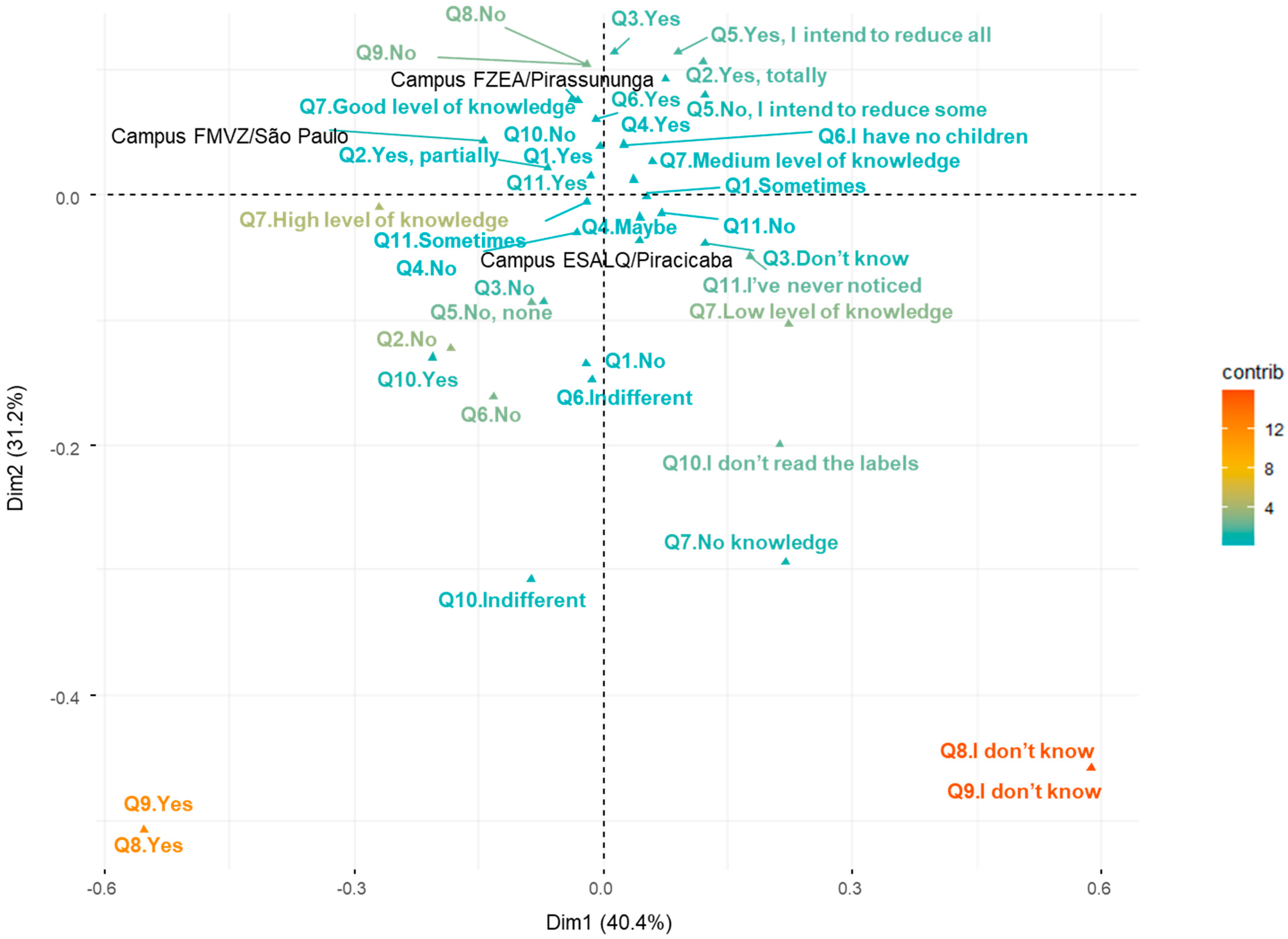
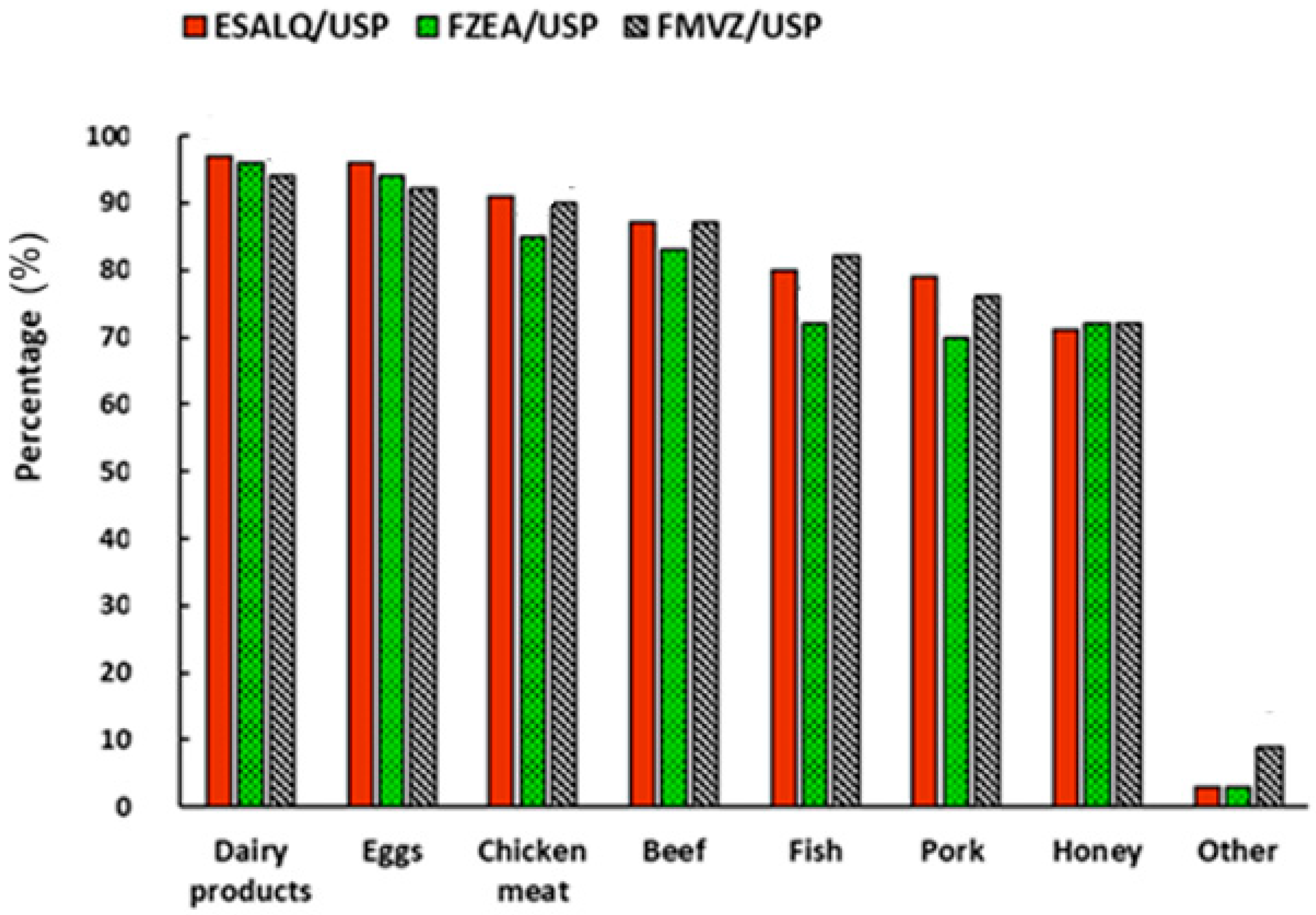
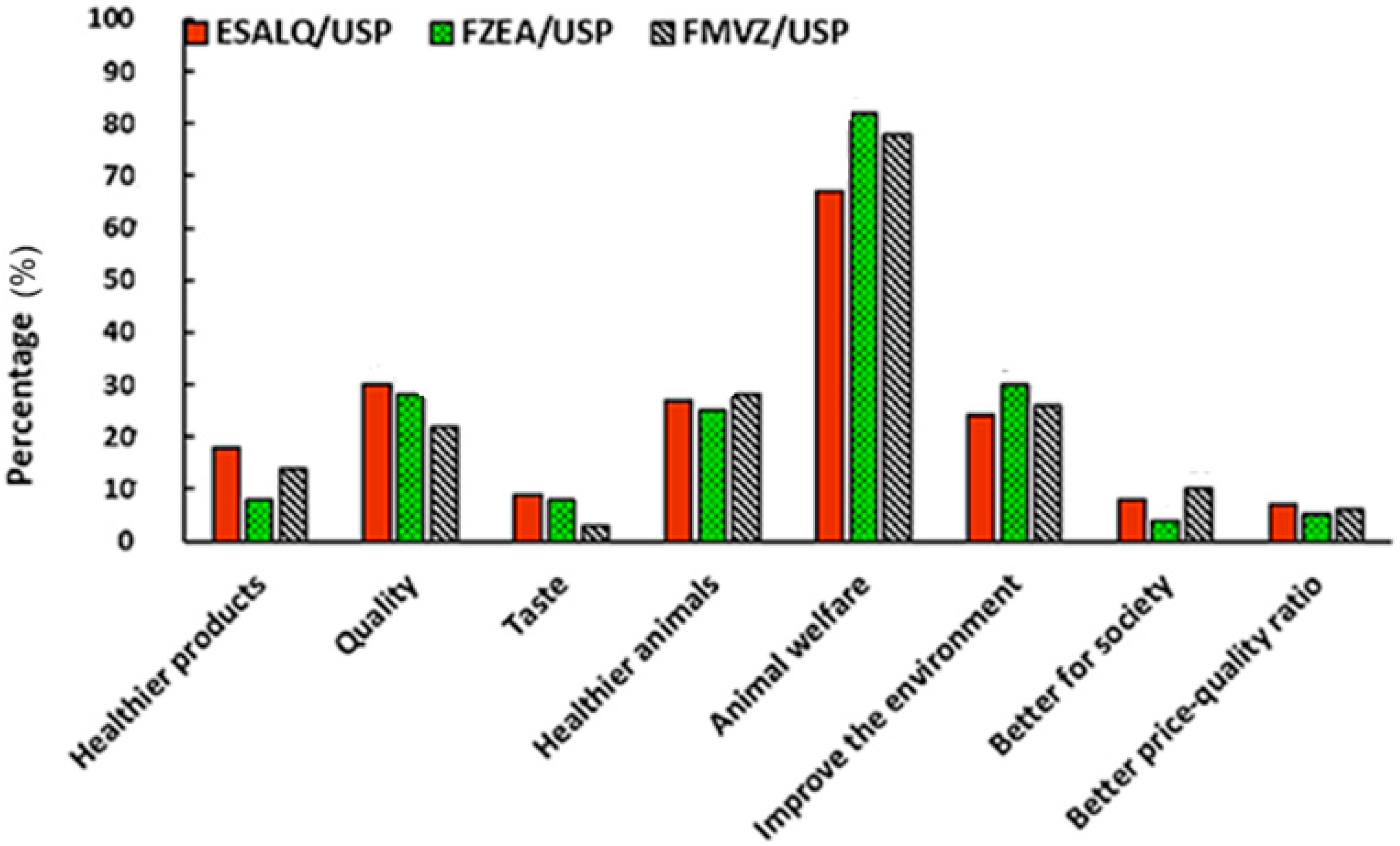
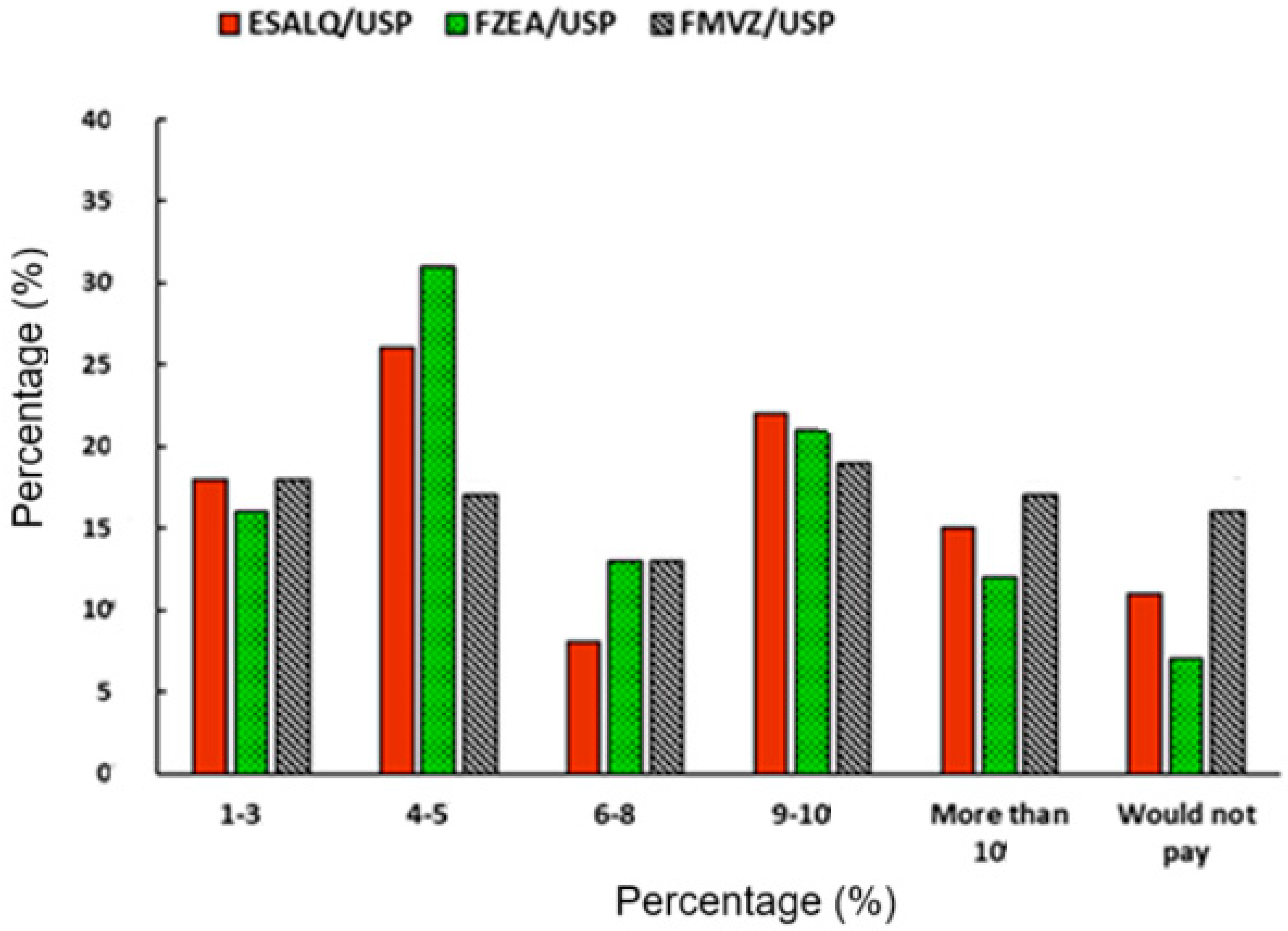
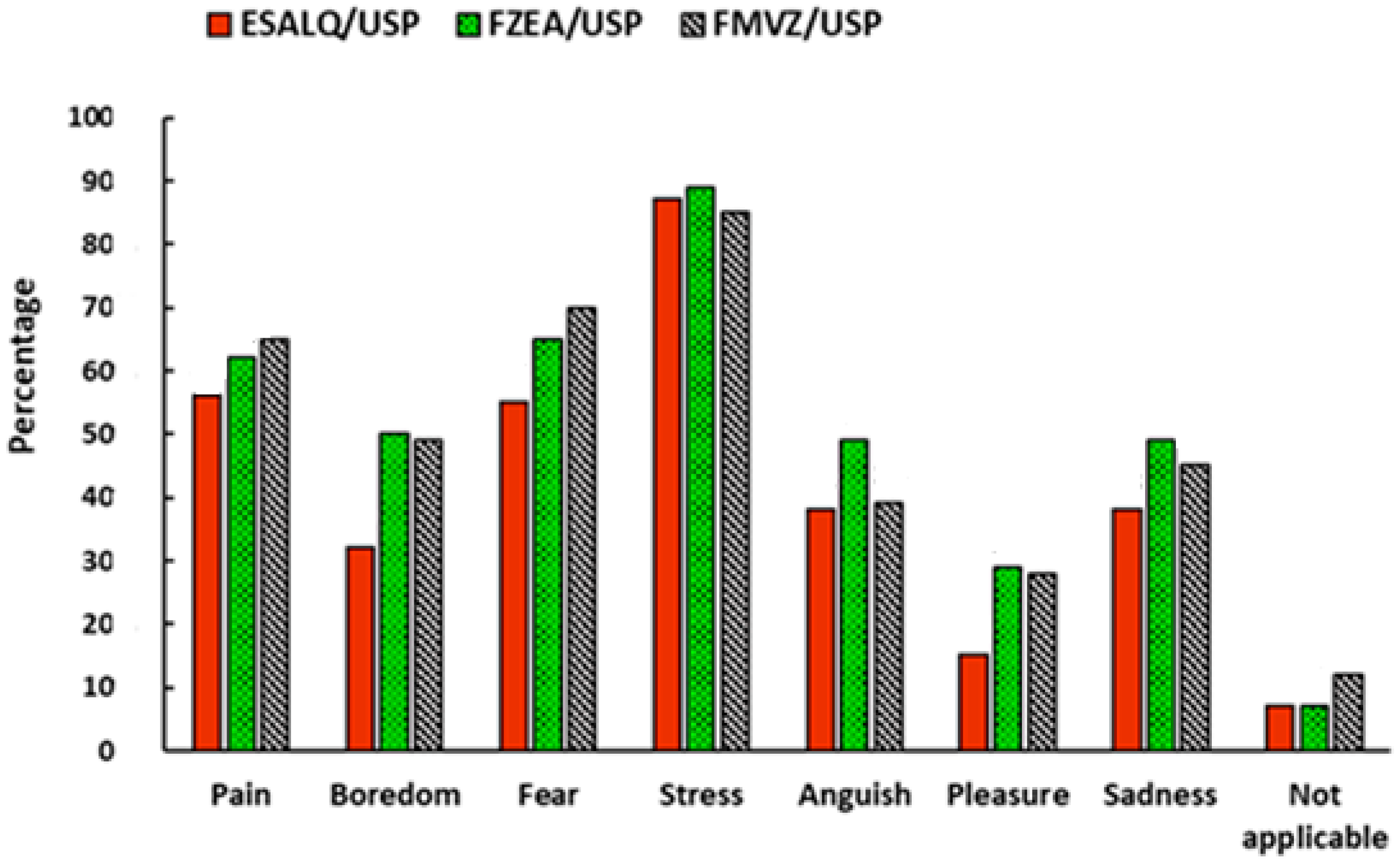

| Campus | City | Undergraduate Courses | Undergraduate Students | Graduate Students |
|---|---|---|---|---|
| “Luiz de Queiroz” College of Agriculture (ESALQ) | Piracicaba | Administration, Biology, Food Science, Economics, Agronomy, Forestry, Environmental Management, and License in Agricultural Science | 2031 | 1262 |
| College of Animal Science and Food Engineering (FZEA) | Pirassununga | Food Science, Biosystems Engineering, Veterinary Medicine, and Animal Science | 1305 | 405 |
| School of Veterinary Medicine and Animal Science (FMVZ) | São Paulo | Veterinary Medicine | 726 | 666 |
| ESALQ n = 486 | FZEA n = 174 | FMVZ n = 109 | |
|---|---|---|---|
| Gender (p < 0.001) | |||
| Men | 251 | 146 | 81 |
| Women | 235 | 28 | 28 |
| Age (p < 0.001) | |||
| <18 | 2 | 5 | 1 |
| 18–24 | 168 | 134 | 25 |
| 25–30 | 110 | 29 | 35 |
| 31–40 | 67 | 6 | 19 |
| 41–50 | 53 | 0 | 15 |
| 51–60 | 63 | 0 | 11 |
| >60 | 23 | 0 | 3 |
| Education Level (p < 0.001) | |||
| High school | 20 | 15 | 3 |
| Incomplete higher education | 163 | 122 | 24 |
| Complete higher education | 71 | 19 | 11 |
| Incomplete postgraduate | 79 | 12 | 38 |
| Postgraduate (master’s or doctorate) | 153 | 6 | 33 |
| Family income (p < 0.001) | |||
| Up to 3 | 227 | 144 | 52 |
| 4 to 7 | 126 | 37 | 27 |
| 8 to 10 | 52 | 9 | 6 |
| 11 to 15 | 52 | 8 | 18 |
| Over 15 | 29 | 6 | 6 |
| Active Variables | ESALQ (486) | FZEA (174) | FMVZ (109) |
|---|---|---|---|
| Response Levels | |||
| Q1. Do you buy food for your house? (p = 0.104) | |||
| Yes | 344 | 124 | 64 |
| No | 35 | 10 | 139 |
| Sometimes | 107 | 40 | 32 |
| Q2. Would you substitute animal source proteins with other protein sources? (p = 0.316) | |||
| Yes, totally | 111 | 43 | 18 |
| Yes, partially | 262 | 85 | 58 |
| No | 113 | 46 | 33 |
| Q3. Would you consume other types of proteins (ex: meat produced in a lab)? (p < 0.001) | |||
| Yes | 153 | 89 | 49 |
| No | 230 | 51 | 40 |
| Don’t know | 103 | 34 | 20 |
| Q4. Would you consume insect-based foods? (p = 0.021) | |||
| Yes | 151 | 36 | 31 |
| No | 176 | 68 | 50 |
| Maybe | 159 | 70 | 28 |
| Q5. Would you reduce your consumption of animal source products? (p = 0.557) | |||
| Yes, I intend to reduce all | 138 | 57 | 30 |
| Yes, I intend to reduce some | 87 | 25 | 15 |
| No, none | 261 | 92 | 64 |
| Q6. Would you interfere in the quantity of food consumed by your children? (p < 0.001) | |||
| Yes | 124 | 30 | 20 |
| No | 126 | 16 | 24 |
| Indifferent | 27 | 5 | 4 |
| I have no children | 209 | 123 | 61 |
| Q7. Level of knowledge about the conditions of the lives of livestock (p < 0.001) | |||
| No knowledge | 17 | 2 | 4 |
| Low level of knowledge | 104 | 18 | 11 |
| Medium level of knowledge | 195 | 47 | 17 |
| Good level of knowledge | 100 | 65 | 31 |
| High level of knowledge | 70 | 42 | 46 |
| Q8. Is there sufficient information in your country about the well-being of animals? (p = 0.155) | |||
| Yes | 37 | 14 | 9 |
| No | 390 | 146 | 95 |
| I don’t know | 59 | 14 | 5 |
| Q9. Would you like to be informed on the conditions of animal rearing? (p = 0.007) | |||
| Yes | 399 | 161 | 91 |
| No | 45 | 6 | 5 |
| I don’t know | 42 | 4 | 4 |
| Q10. Do the packages of animal-based products allow for identifying the conditions the animals were reared in? (p = 0.922) | |||
| Yes | 34 | 11 | 7 |
| No | 398 | 143 | 94 |
| I don’t read the labels | 44 | 17 | 6 |
| Indifferent | 10 | 3 | 2 |
| Q11. Does the presence of the sanitary inspection label influence your intention to purchase? (p < 0.001) | |||
| Yes | 243 | 112 | 74 |
| No | 39 | 3 | 4 |
| Sometimes | 97 | 27 | 11 |
| I’ve never noticed | 107 | 32 | 20 |
Disclaimer/Publisher’s Note: The statements, opinions and data contained in all publications are solely those of the individual author(s) and contributor(s) and not of MDPI and/or the editor(s). MDPI and/or the editor(s) disclaim responsibility for any injury to people or property resulting from any ideas, methods, instructions or products referred to in the content. |
© 2025 by the authors. Licensee MDPI, Basel, Switzerland. This article is an open access article distributed under the terms and conditions of the Creative Commons Attribution (CC BY) license (https://creativecommons.org/licenses/by/4.0/).
Share and Cite
Patinho, I.; Silveira, R.M.F.; Saldaña, E.; Arno, A.; Castro Júnior, S.L.d.; Silva, I.J.O.d. A Multidisciplinary View on Animal Welfare and Alternative Protein: Convergences and Perspectives from Professionals in Agricultural, Food, and Veterinary Sciences. Foods 2025, 14, 2140. https://doi.org/10.3390/foods14122140
Patinho I, Silveira RMF, Saldaña E, Arno A, Castro Júnior SLd, Silva IJOd. A Multidisciplinary View on Animal Welfare and Alternative Protein: Convergences and Perspectives from Professionals in Agricultural, Food, and Veterinary Sciences. Foods. 2025; 14(12):2140. https://doi.org/10.3390/foods14122140
Chicago/Turabian StylePatinho, Iliani, Robson Mateus Freitas Silveira, Erick Saldaña, Alessandra Arno, Sérgio Luís de Castro Júnior, and Iran José Oliveira da Silva. 2025. "A Multidisciplinary View on Animal Welfare and Alternative Protein: Convergences and Perspectives from Professionals in Agricultural, Food, and Veterinary Sciences" Foods 14, no. 12: 2140. https://doi.org/10.3390/foods14122140
APA StylePatinho, I., Silveira, R. M. F., Saldaña, E., Arno, A., Castro Júnior, S. L. d., & Silva, I. J. O. d. (2025). A Multidisciplinary View on Animal Welfare and Alternative Protein: Convergences and Perspectives from Professionals in Agricultural, Food, and Veterinary Sciences. Foods, 14(12), 2140. https://doi.org/10.3390/foods14122140







